Beginner’s Guide to Stand-Up Comedy as a Hobby: Tips to Get Started
Starting stand-up comedy as a hobby can be a thrilling and rewarding experience. It allows you to express your creativity, connect with others, and exercise your wit.
Stand-up comedy involves developing your unique comedic voice and crafting material that truly reflects who you are.
This journey is about sharing real-life experiences, thoughts, and observations in a humor-filled manner.

Performing at open mic events is an excellent way to dive into this vibrant world. These events provide a low-pressure environment where you can test new material and learn how to engage with an audience.
You’ll grow as a comedian by observing what works and what doesn’t, and refining your performance based on feedback.
The journey doesn’t end with open mics. Building a presence in the comedy scene is crucial as you look to advance your skills.
Networking with other comedians, learning from each gig, and continuously honing your act for different audiences will help you grow.
This guide is here to support you in navigating these stages, offering practical tips and encouraging you to use your voice to make people laugh.
Key Takeaways
- Develop your unique comedic voice by sharing genuine experiences.
- Use open mics to practice and refine your comedy skills.
- Build your presence by networking and continuously improving your act.
Understanding Stand-Up Comedy
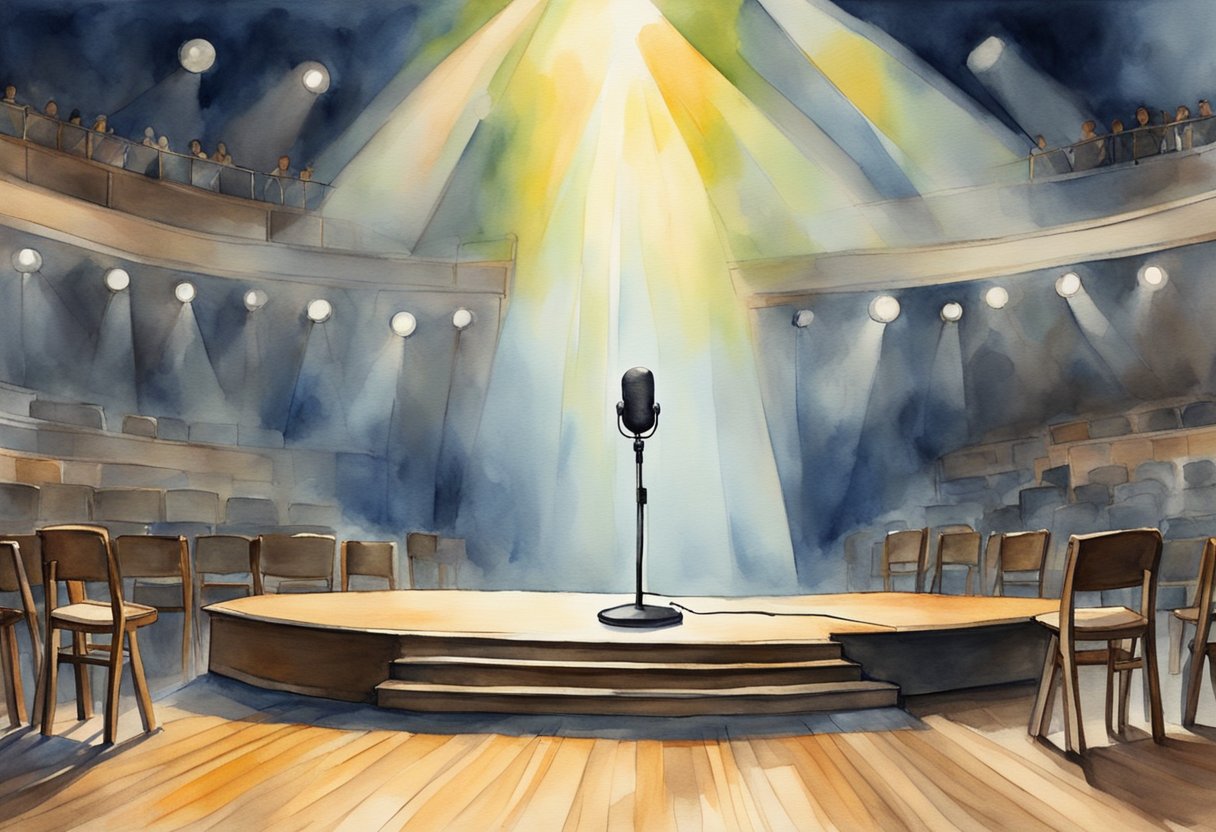
Stand-up comedy is a unique art form where comedians use humor to connect with audiences. It’s rooted in history and features various styles, allowing diverse expressions of wit and creativity.
History of Standup Comedy
Stand-up comedy has evolved significantly since its early days. It started in the 19th century with acts in minstrel shows and vaudeville. Over time, comedians began focusing more on stand-up as a distinct performance. By the mid-20th century, stand-up had become a mainstay in nightclubs and theaters, especially in the United States.
You can explore how the genre shifted from vaudeville acts to the rise of personalities like Richard Pryor and George Carlin in the 1970s. Understanding its history helps you appreciate the diverse voices and styles that have shaped it over the years.
Comedy Styles
There are various styles in stand-up comedy that offer unique approaches to humor. Observational comedy is popular and involves making witty remarks about everyday life. Comedians like Jerry Seinfeld excel in this style.
Meanwhile, satire uses irony and sarcasm to comment on society and politics, with performers like Jon Stewart as notable examples.
Alternative comedy challenges traditional forms, often with absurd or surreal elements.
Understanding these styles allows you to appreciate the nuances of different comedic performances and possibly find your niche if you are trying to become a comedian.
The Role of a Stand-Up Comedian
As a stand-up comedian, your role is both challenging and rewarding. You need to develop a strong connection with your audience using humor.
Writing your material requires creativity, as you must craft relatable jokes and punchlines that resonate with diverse crowds.
It is important to read the room and adapt your delivery based on audience reactions, which can improve your timing and stage presence.
Comedians are often seen as truth-tellers, using humor to address social issues and provoke thought while entertaining.
Mastering the art of stand-up involves honing performance techniques and continuously evolving your style to engage audiences effectively.
Developing Your Comedic Voice

Finding your comedic voice is essential in stand-up comedy. It involves observing life, telling stories in engaging ways, and sometimes using satire to make a point. Each approach offers unique advantages and can help carve out your niche in comedy.
Observational Humor
Observational humor is about noticing the little things in everyday life that others might miss. As a comedian, you’ll observe common scenarios and highlight their humor. This requires a keen eye and an ability to see the absurdity in the mundane.
Use relatable content. Talking about situations your audience knows helps in forming a connection. Discuss topics like family quirks, awkward social interactions, or odd experiences.
Timing is vital. Deliver punchlines at the right moment to maximize laughter. Practicing your timing will improve your delivery.
Storytelling
This technique is about weaving tales that captivate the audience while sprinkling in humor. Storytelling involves creating a narrative arc, with a beginning, middle, and end, while infusing it with comedy.
Build engaging characters in your stories. Giving them distinct traits makes the narrative vivid. Your stories should have a relatable premise or a surprising twist to keep the audience engaged.
Mix truth with fiction. Blend real-life experiences with exaggerations to enhance the comedic effect. Balance the storytelling with humor to keep the audience entertained.
Satire
Satire uses humor to criticize or point out flaws in society or human behavior. It can be challenging but rewarding when done well. Satire often involves wit and irony to convey messages.
Choose subjects carefully. Targeting topical events or universal issues can resonate with audiences. Ensure your satire punches up; aim humor at those in positions of power rather than marginalized groups.
Be bold but sensitive. While satire can be edgy, it’s essential to remain respectful. The goal is to provoke thought without crossing lines that alienate the audience. Balancing these aspects can make satire an effective comedic tool.
Crafting Your Material

Creating a compelling stand-up comedy routine involves understanding the art of joke writing and structuring a cohesive monologue. Mastering these skills can greatly enhance your comedic performance.
Joke Writing Basics
Crafting jokes is the foundation of your stand-up routine. Start by identifying a humorous premise, which is the idea that forms the basis of your joke. Think about everyday situations, personal experiences, or common observations.
The setup of your joke introduces this premise, leading the audience toward an expected conclusion. Then, deliver the punchline, an unexpected twist that surprises and amuses the audience.
Practice timing to emphasize the punchline, making sure to pause briefly after delivering it. This gives the audience time to react. Analyze successful comedians, noting how they structure their jokes for maximum impact.
Building a Monologue
A monologue involves stringing together several jokes that follow a central theme or narrative. Begin by outlining the main topic you want to cover. It might be something personal or a commentary on societal issues.
Use this central theme to create a natural flow between jokes. Each joke should build upon the last, enhancing the narrative.
Use callbacks, which are references to earlier jokes in the routine. They create continuity and reward attentive listeners.
Maintain a balance between scripted material and improvisation. This keeps your performance fresh and engaging. Novice’s Guide suggests experimenting with different styles to find what works best for you.
Delivering Your Act
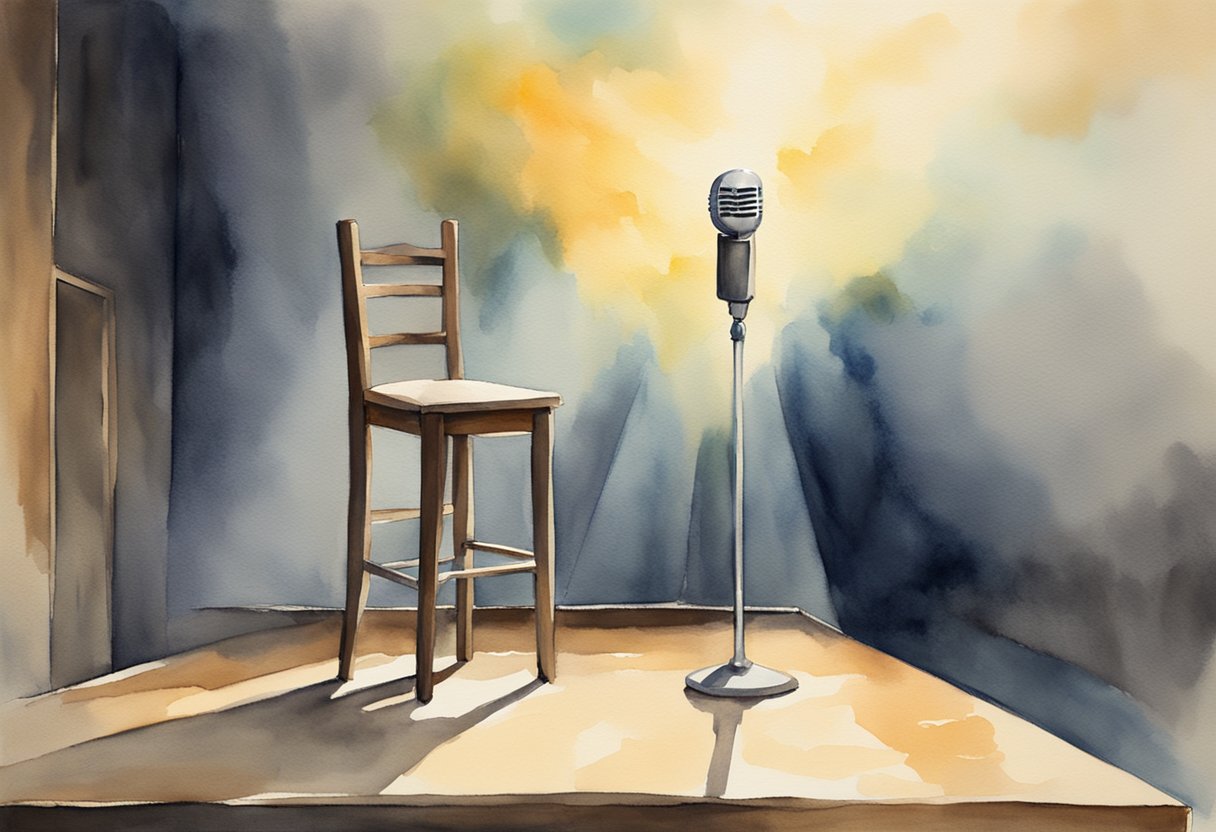
Delivering your stand-up comedy act involves mastering timing, honing body language and facial expressions, and managing stage fright. Each element plays a crucial role in engaging your audience and making your performance memorable.
Timing and Delivery
Timing is central to your comedic delivery. It’s not just about when you say your jokes, but how you use pauses and rhythm to build anticipation.
Successful comedians often pause before a punchline to let the audience hang on their words. Practice your routine repeatedly to get comfortable with this flow. Observing comedians you admire can also help you understand effective timing.
Good delivery is about the clarity and energy in your performance. Make sure your voice is clear and loud enough for the room. Vary your tempo and tone to keep your act engaging.
A steady, confident delivery can enhance your jokes and help you win over the crowd.
Body Language and Facial Expressions
Body language is a powerful tool for adding depth to your comedy. Using gestures, facial expressions, and movements can emphasize your jokes and keep the audience engaged.
For instance, exaggerating a shrug or rolling your eyes can add humor beyond the words.
Facial expressions help convey emotions and reactions, making your performance more relatable. Practice in front of a mirror or record yourself to refine these visual cues. Experiment to see what feels natural and enhances your storytelling.
Effective use of both body language and facial expressions makes your comedy more animated and enjoyable. With practice, you’ll find a style that complements your sense of humor.
Dealing with Stage Fright
Stage fright is common among performers, even experienced ones. Preparation is key to managing this anxiety.
Familiarize yourself with your material so that confidence grows each time you rehearse. Visualization techniques, like picturing a successful performance, can also be helpful.
Take deep, calming breaths before stepping onstage to steady your nerves. Embrace the adrenaline as excitement, not fear.
Remember that it’s normal to feel nervous, and even seasoned comedians experience similar feelings.
Connecting with your audience can reduce anxiety. Picking out a friendly face or starting with a familiar joke can help ease initial jitters.
As you gain experience, stage fright often diminishes.
Gigging: Starting Out
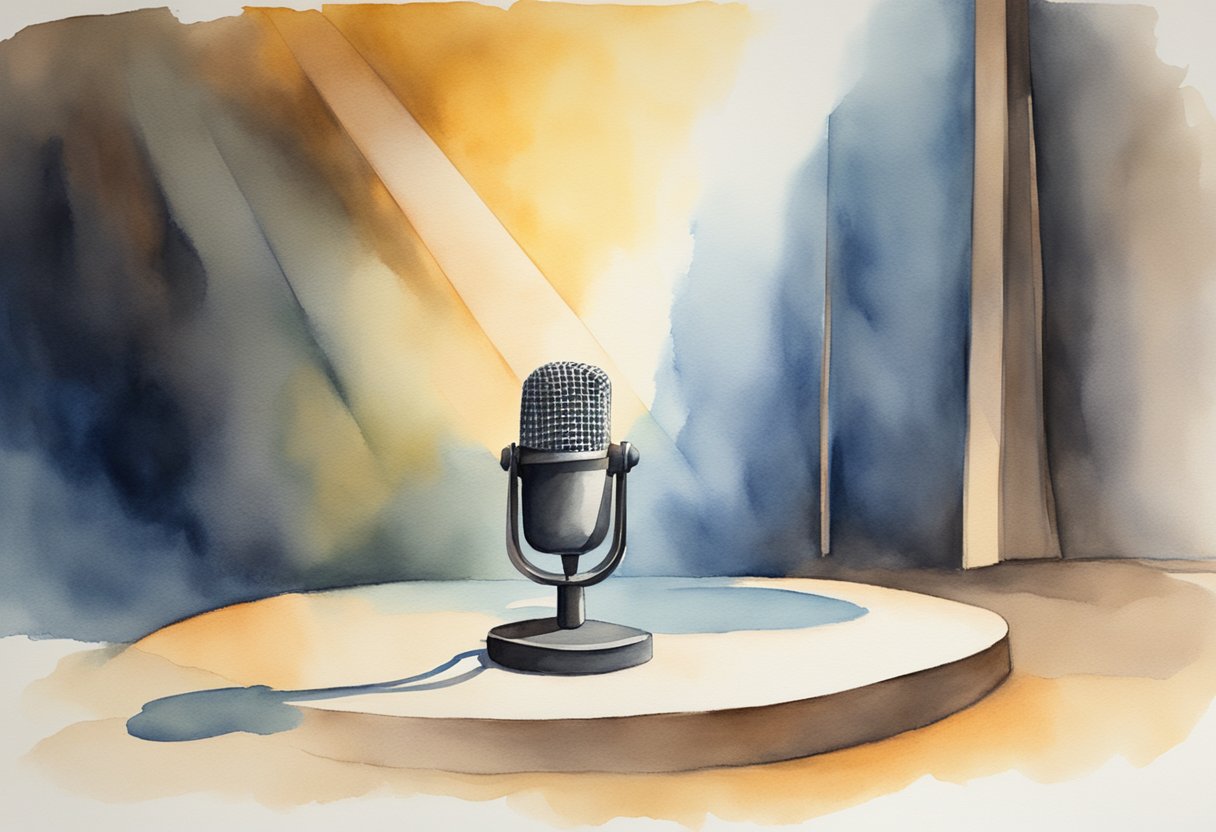
Starting your journey in stand-up comedy involves finding the right opportunities for performance and understanding the norms of comedy venues. These aspects are crucial as they help you gain stage time and connect with audiences.
Finding Open Mics
Open mics are an essential starting point for new comedians. These events give you the chance to practice your routine and test material in front of a live audience.
Start by checking local listings online or on social media platforms to find nearby open mic nights. Many comedy clubs and bars host these events regularly, so keeping an eye on their schedules can be beneficial.
Consider attending a few open mic sessions as an audience member before performing. This can help you gauge the general vibe and crowd preferences.
Remember to sign up early as spots often fill up quickly. Networking with other comedians can also provide valuable insights and tips for your performance.
Comedy Club Etiquette
Understanding comedy club etiquette is vital for making a good impression. When performing at a club, be respectful to both staff and fellow performers.
Arrive on time and introduce yourself to the host. Always adhere to your allotted stage time; going over your time limit is disrespectful and can disrupt the event schedule.
Avoid using jokes that are clearly in poor taste, as this can reflect poorly on you and be uncomfortable for the audience.
Watch others perform to understand what works well. Lastly, be supportive of other comedians performing before and after you. Applauding them and offering positive feedback fosters a friendly and collaborative environment.
Engaging the Audience
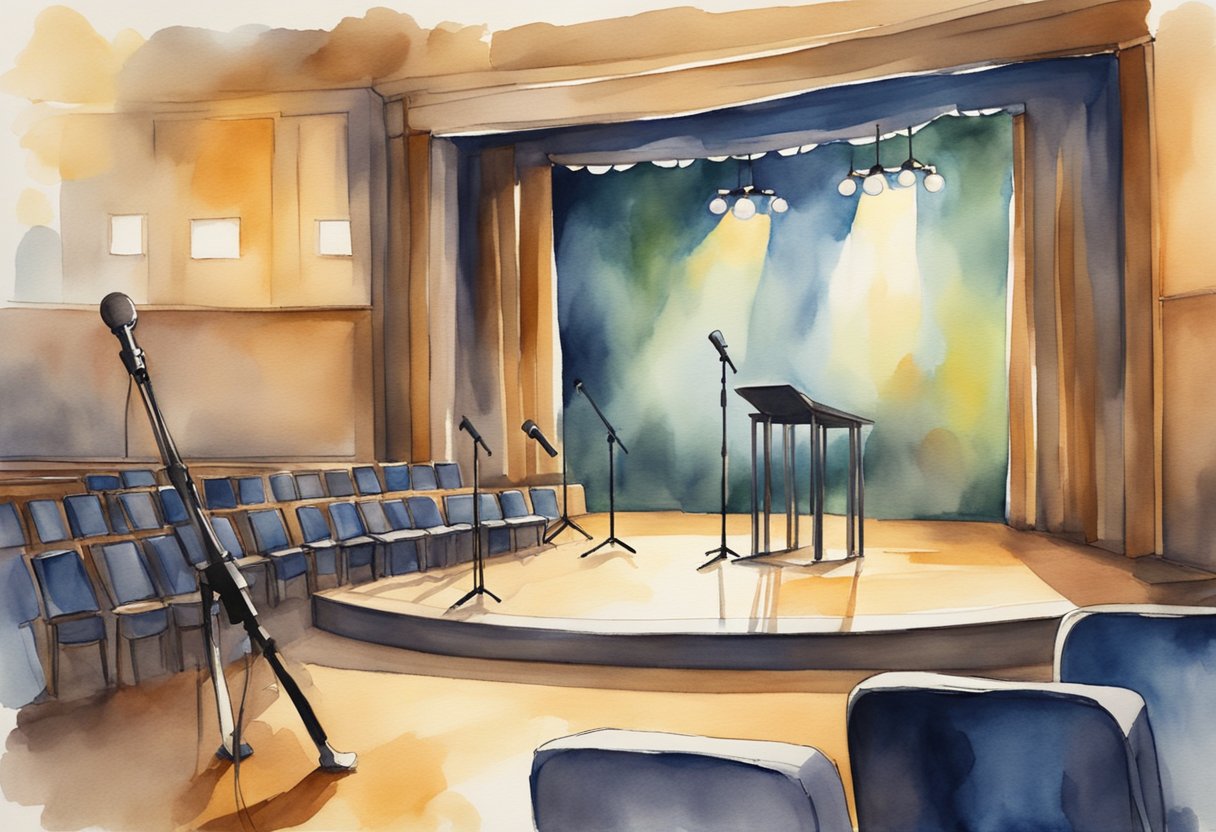
To connect with your audience in stand-up comedy, focus on interaction and be ready to handle any disturbances.
Knowing how to engage people can turn a good performance into an unforgettable one.
Audience Interaction
Engaging your audience starts with observing their reactions and adapting your performance.
Pay attention to laughter cues, as this helps you understand which jokes resonate.
Be flexible to adjust your pacing and material according to their feedback.
Establish eye contact to create a more intimate connection.
Use gestures and body language to express your jokes vividly.
Inviting audience participation can also strengthen engagement.
Ask questions or include them in a joke to make them feel included.
Active listening is crucial.
Respond thoughtfully to unexpected comments or reactions, making the audience feel valued.
Tailoring your act to the energy in the room can lead to more memorable moments.
Handling Hecklers
Dealing with hecklers requires a calm and collected approach.
Hecklers can disrupt the flow, so it’s important to address them without losing your cool.
Start by acknowledging them with a light-hearted remark, turning the interruption into a part of the act.
Choose your words wisely. A well-delivered comeback can reclaim control and even turn the heckler into an ally.
Keep it friendly to avoid alienating others who might side with the heckler.
Sometimes, hecklers might persist. In these cases, gently remind them of the show’s boundaries.
By maintaining composure and a sense of humor, you can keep the audience on your side and maintain engagement throughout the performance.
Learning from Experience

Developing your skills in stand-up comedy involves learning from various experiences.
By gathering feedback and analyzing your performances, you can sharpen your comedic potential and build resilience in comedy.
Gathering Feedback
Feedback is essential for any comedian striving to improve.
After a performance, seek input from both the audience and fellow comedians.
Audience reactions give you immediate insight into what works and what doesn’t. You can ask for feedback directly or listen closely to laughs, claps, and overall engagement during your set.
Connecting with other comedians is also helpful.
They can offer advice from their own experiences that can guide you.
Be open to constructive criticism, as it highlights areas needing improvement.
Keeping a journal of feedback allows you to track your progress over time and adjust your material and delivery.
Analyzing Performances
Reviewing past performances is crucial for personal growth in stand-up comedy.
Recording your sets helps you reflect on what went well and what left room for improvement.
Watch each recording to analyze timing, delivery, and audience interaction.
Pay attention to the effectiveness of your punchlines and transitions.
Notice how certain elements of your routine influence audience reactions.
Are there repeated mistakes or points where the audience disengages?
Comparing different performances can unearth patterns that inform your future shows.
Identifying these patterns not only strengthens your act but also builds resilience as you adapt your style.
Understanding how your audience responds to different elements helps unleash your full comedic potential.
Building a Presence
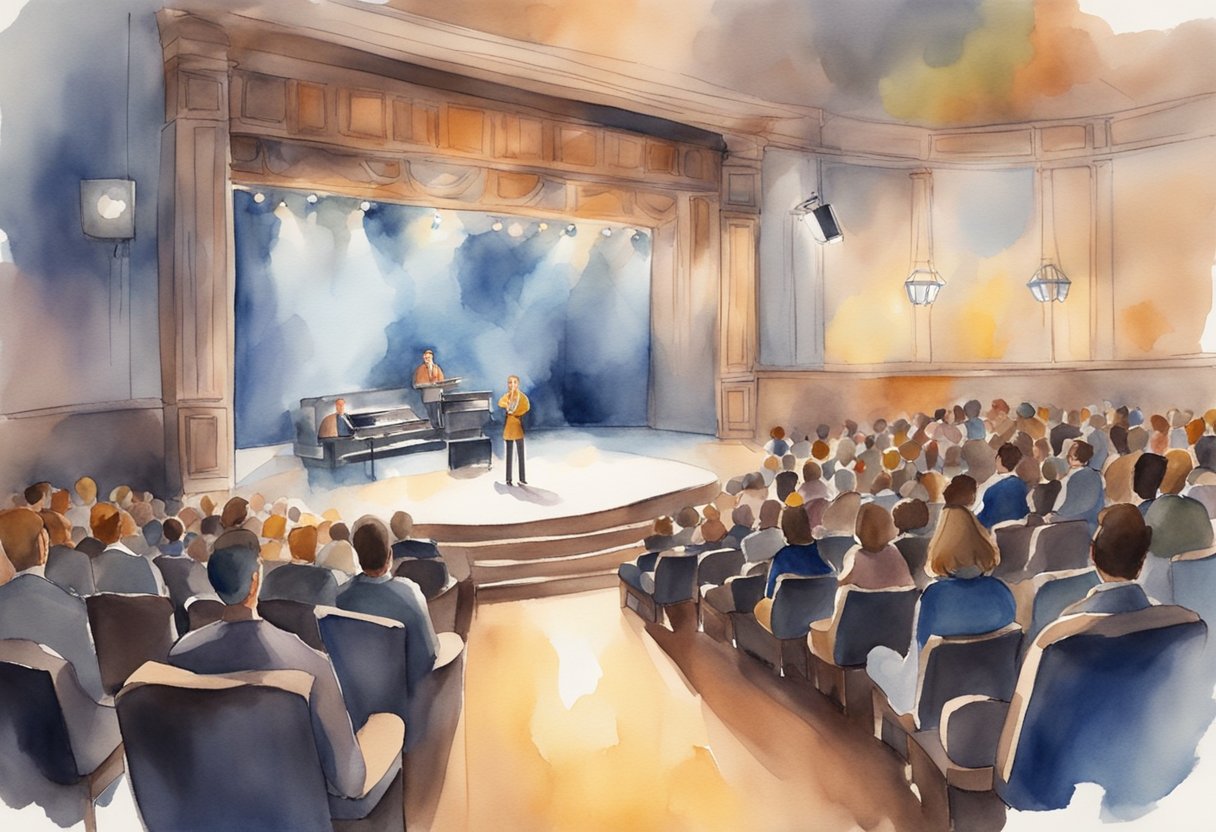
Creating a presence in the world of stand-up comedy involves both online engagement and forming connections with fellow comedians.
By effectively using social media and networking, you can increase your visibility and opportunities in the comedy scene.
Establishing an Online Presence
To build your online presence, start by creating profiles on platforms like Instagram, Twitter, and TikTok.
Share clips from your performances and post updates about upcoming gigs.
Engaging with your followers through comments and messages can turn them into a supportive audience.
A personal website can serve as a hub for all your content and accomplishments.
Include your bio, a calendar of shows, and contact information. This makes it easier for fans and potential collaborators to find you.
Consider starting a YouTube channel where you can upload full sets or skits.
This opens up opportunities to reach a wider audience, and it’s a great way to get feedback on your work.
Social media helps you connect directly with your audience and can lead to more performance opportunities at comedy shows.
Networking with Comedians
Networking with other comedians is essential for building a presence.
Begin by attending local comedy shows and open mics.
Introduce yourself to other performers and share insights or jokes.
This can lead to gig opportunities and helpful advice from more experienced comedians.
Join online comedy forums and groups. Platforms like Facebook and Reddit have spaces where comedians exchange ideas and tips.
These communities can provide support and keep you informed about upcoming events.
Make connections with gatekeepers, such as comedy club managers and bookers.
They play a significant role in securing stage time.
Building rapport with these individuals can open doors to bigger gigs and collaborations.
Regular interaction with comedians and gatekeepers strengthens your place in the comedy network.
Advancing Your Comedy Career
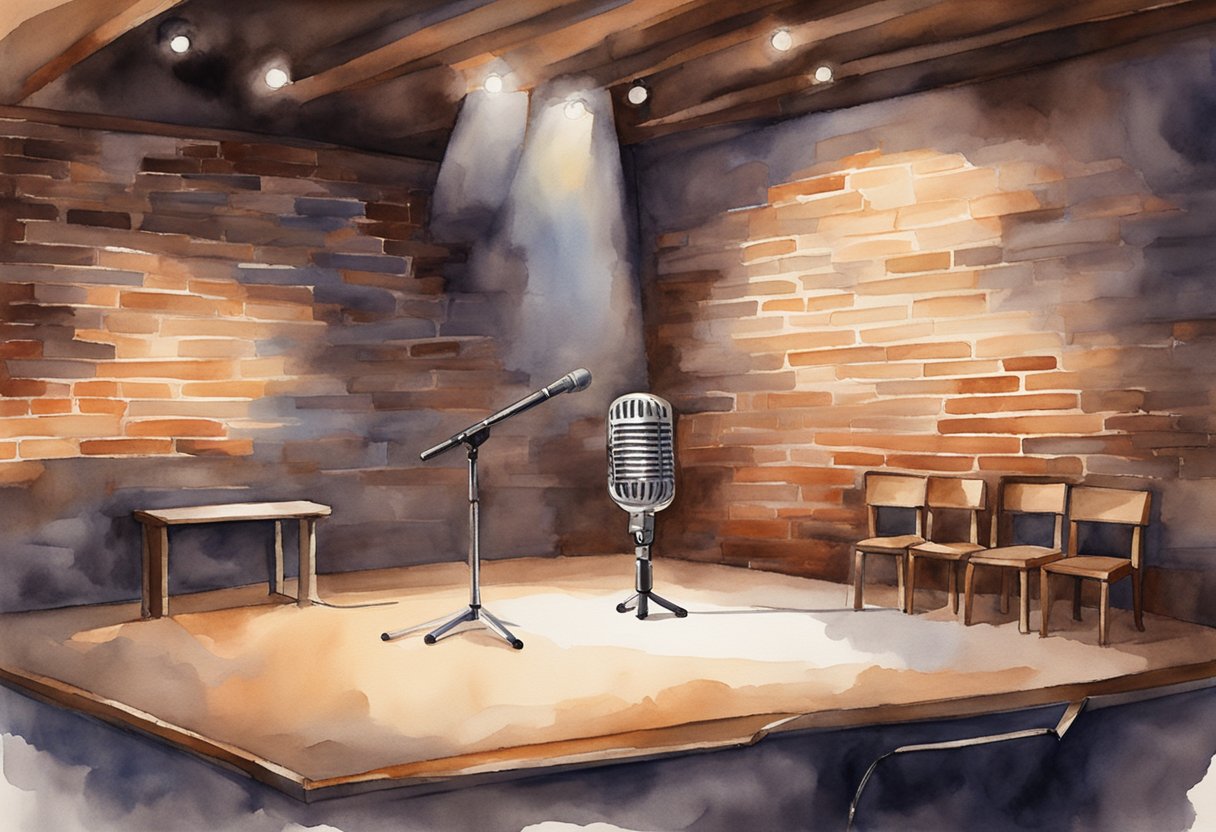
Getting serious about stand-up comedy involves taking strategic steps to further your career.
You should consider participating in events and teaming up with fellow comedians to expand your network and skills.
Participating in Comedy Festivals
Comedy festivals can be a great opportunity to showcase your talent.
Many festivals offer platforms for both established and emerging stand-up comedians.
When considering which festivals to attend, research those that align with your comedic style.
Applying to perform may require submitting a video of your set, so choose one that highlights your best work.
Festivals not only provide exposure but also offer networking opportunities.
You’ll meet comedians from various backgrounds and levels of experience.
This environment can be inspiring and educational, offering you a glimpse into different styles and approaches.
Even attending as an audience member can be valuable; observing other performers can give you fresh ideas and insights.
Collaborating with Other Comedians
Working with fellow comedians can bring about new creative avenues.
Collaboration can happen through joint performances, writing partnerships, or even forming a comedy group.
Being around other talented individuals helps you refine your skills by receiving feedback and support.
Building relationships with other comedians can open doors to more stage time and varied audiences.
For instance, if you collaborate on a show or tour together, it may lead to chances to perform in front of diverse crowds.
Additionally, collaboration can introduce you to different styles of comedy, encouraging you to experiment with your material.
Reach out to comedians whose work you admire—offer to write together or attend their shows.
Such interactions foster a community that supports growth.
Honing Your Act for Diverse Venues

Adapting your stand-up comedy routine to different settings is crucial for success.
This involves tailoring your material to suit the venue, city, and audience for maximum impact.
Performing in Different Cities
When taking your act to new locations, consider the local culture and humor.
Cities like Atlanta may have unique tastes, partly shaped by local humorists like Hollis Gillespie. Research these nuances and incorporate relatable references into your act.
Additionally, logistics like travel and stage setup impact your performance.
Familiarize yourself with the venue’s layout and technical aspects to avoid surprises.
Planning helps you maintain focus on delivering a seamless performance. Being prepared enhances your confidence and allows you to engage more effectively with the audience.
Adjusting to Various Audiences
Understanding and connecting with diverse audiences is key.
Analyze crowd demographics to tailor your content.
For instance, a college crowd might prefer edgy humor, while a more mature audience might appreciate wit and storytelling.
Flexibility ensures that you maintain audience engagement, even if your initial jokes fall flat.
Pay attention to audience reactions and adjust your tone, timing, or topics as needed.
Observing experienced comedians can provide insights into managing different audiences.
This adaptive skill makes your performance more engaging and memorable.
Frequently Asked Questions
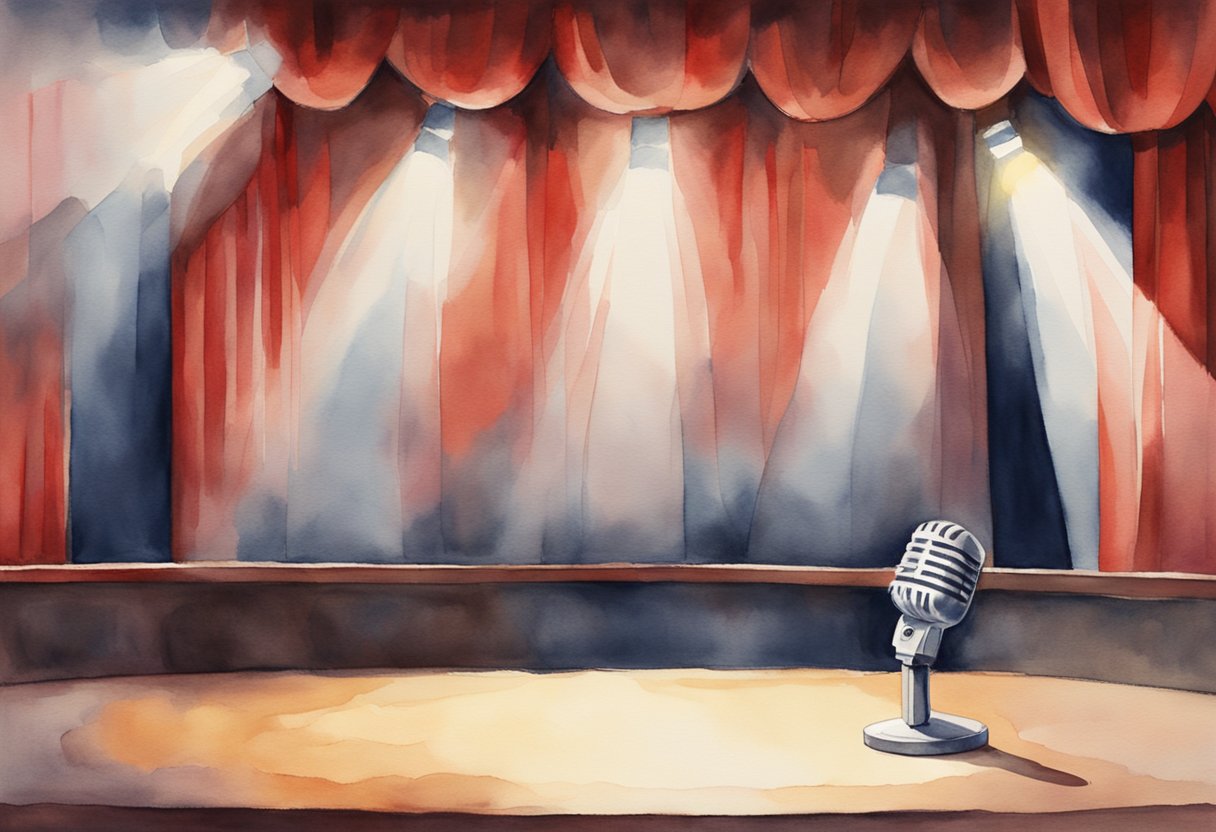
Exploring stand-up comedy as a hobby can be both exciting and challenging. Understanding how to prepare for a performance, write scripts, and develop your style can help you succeed in the world of comedy.
How can I prepare for my first stand-up comedy performance?
Start by attending open mic nights to get a feel of the environment.
Practice your routine in front of friends or family to build confidence.
Focus on perfecting your timing and delivery to ensure you connect with the audience.
What are some essential tips for writing a stand-up comedy script?
Begin with collecting your funny ideas and then turn them into jokes with a clear setup and punchline.
Be true to your personal experiences and observations, as authenticity resonates with the audience.
Keep your jokes concise and practice them repeatedly to refine your script.
Are there specific rules or guidelines to follow in stand-up comedy?
While creativity is encouraged, it’s important to respect the audience and avoid offensive material.
Focus on your unique voice and ensure that your humor is both relatable and appropriate.
Staying true to your style will help you stand out.
How can I develop my own stand-up comedy style?
Developing your style involves experimenting with different types of humor and delivery techniques.
Analyze performances by comedians you admire and incorporate elements that align with your personality.
Keep performing and refining your approach based on audience feedback.
What are the benefits of taking stand-up comedy classes?
Stand-up comedy classes can improve your writing and performing skills.
You’ll learn improvisation, timing, and how to develop your unique comedic voice.
Classes offer structured feedback and a supportive environment to hone your craft.
Where can I find resources or communities for aspiring stand-up comedians?
Look for local comedy clubs and online forums dedicated to comedy.
Websites like BingeHobby offer articles and guides for beginners.
Joining groups with similar interests can provide networking opportunities and valuable insights.

